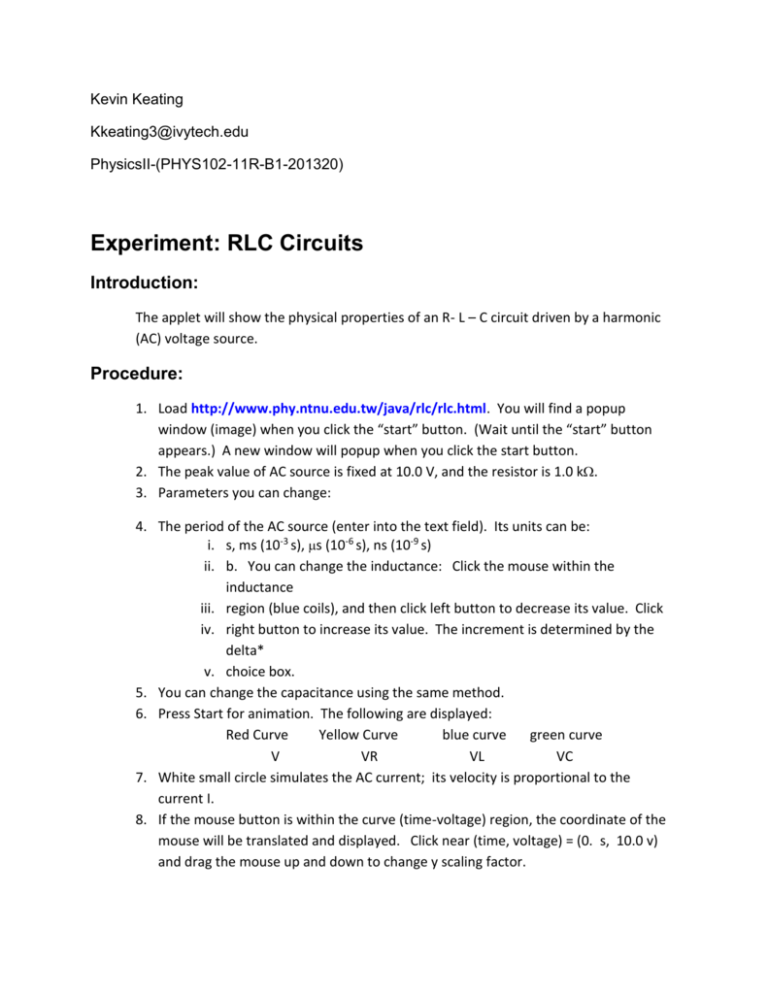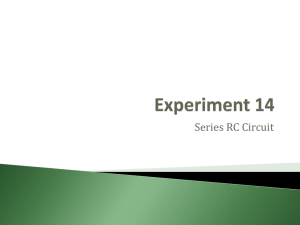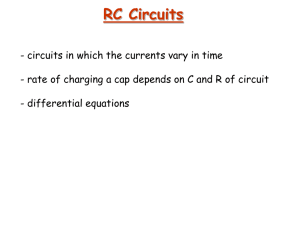RLC Circuits Lab - Ivy Tech -
advertisement

Kevin Keating Kkeating3@ivytech.edu PhysicsII-(PHYS102-11R-B1-201320) Experiment: RLC Circuits Introduction: The applet will show the physical properties of an R- L – C circuit driven by a harmonic (AC) voltage source. Procedure: 1. Load http://www.phy.ntnu.edu.tw/java/rlc/rlc.html. You will find a popup window (image) when you click the “start” button. (Wait until the “start” button appears.) A new window will popup when you click the start button. 2. The peak value of AC source is fixed at 10.0 V, and the resistor is 1.0 k. 3. Parameters you can change: 4. The period of the AC source (enter into the text field). Its units can be: i. s, ms (10-3 s), s (10-6 s), ns (10-9 s) ii. b. You can change the inductance: Click the mouse within the inductance iii. region (blue coils), and then click left button to decrease its value. Click iv. right button to increase its value. The increment is determined by the delta* v. choice box. 5. You can change the capacitance using the same method. 6. Press Start for animation. The following are displayed: Red Curve Yellow Curve blue curve green curve V VR VL VC 7. White small circle simulates the AC current; its velocity is proportional to the current I. 8. If the mouse button is within the curve (time-voltage) region, the coordinate of the mouse will be translated and displayed. Click near (time, voltage) = (0. s, 10.0 v) and drag the mouse up and down to change y scaling factor. 9. Press mouse button to suspend the animation. If you click the left mouse button, animation will resume when you release the mouse button. If you click the right mouse button, you need to click it again. 10. Press the “Reset: button to reset parameters. 11. Use at least three separate values of capacitance and inductance in your analysis. 12. Press “Quit” or Close the window to Quit. Data and Observations: 1. The phase angle between VC (Voltage of capacitor) and VL (Inductor) = 180 2. The phase angle between VR (Resistor) and VL or VC = 90 3. VL increases with the frequency, therefore to increase VL the frequency must increase. 4. VC increases with the frequency, therefore to increase VC the frequency must increase. 5. VR is proportional to the current in that as VR increases so does the current. The current can be increased by decrease the size of the inductor or increasing the size of the capacitor. As a result when VL is at its lowest and VC is at its highest the current is also at its maximum. 6. V ≠ VR + VL + VC VL(blue) > V(red) due to a back emf from the capacitor. Conclusions: The phase angle between the voltage of the capacitor and the voltage across the inductor is 180 degrees while the phase angle between the voltage of the capacitor and the inductor is 90 degrees to the voltage across the resistor. As frequency increases so does the voltage in the capacitor as well as the voltage across the inductor. The total of the voltage across the resistor, inductor and the voltage of the capacitor is less than the voltage from the source due to back emf from the capacitor. Posted: Nov 18, 2013 8:25 PM








